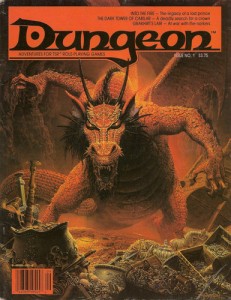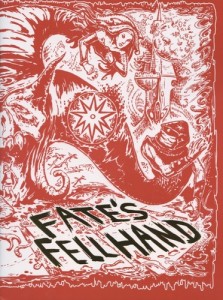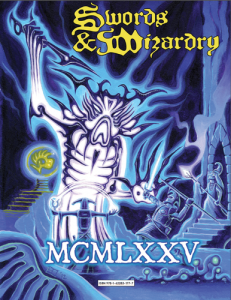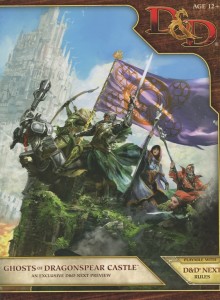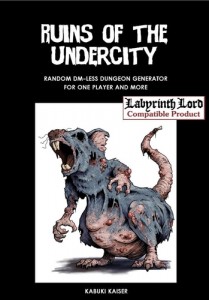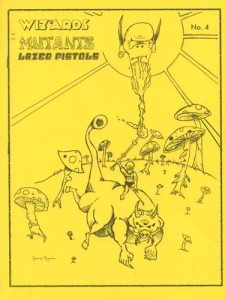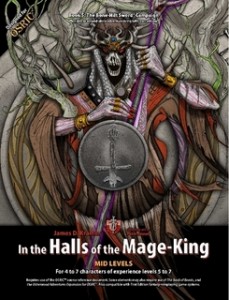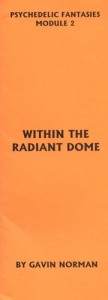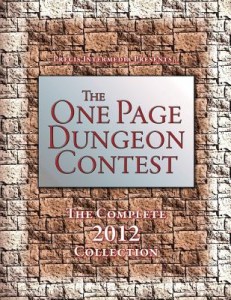
by a shit-ton of authors
Precis Intermedia
The Task: design a complete dungeon in one page. The Complete 2012 Collection. Includes all 106 submissions, including the 24 winning entries.
Welcome! I’m Bryce Lynch! I review OSR material, mostly. I’m a tough reviewer. REALLY tough. I’m generally not TOO arbitrary and I have a set of standards I TRY to keep to. Next time I do this I think I need to do a bunch of longer reviews, maybe three to five in a ‘single’ review. As it is now I think these are comments to the authors rather than reviews people can use?
This is a print collection of all of the entires in the 2012 One Page Dungeon contest. Great as a coffee-table book. Great as an idea generator. Some of the entries would look sweet blown up and framed on the wall. Many are obtuse or one-trick ponies and oh what a clever boy am I is rampant. So, generally meaningless for running adventures but worth having for the diversity of ideas it presents. I really like the print compendium format of the collection. It allows for a kind of pick-up and peruse use of the content.
A few reply comments have stuck with me. One of them was something to effect of: “for many of these adventures yours will be the only review or feedback they ever great.” So, uh, no pressure. Or, rather, let’s graduate from bashing one person per post to bashing LOTS of designers per post! Huzzah!
Meckwick’s Pair o’Dice – Aaron Frost & Mundi King – Winner: Best Dungeon Generator
This includes a pair of cut out dice that you assemble yourself. One die determines the shape of the room you are in and the other determines the enemy you face in the room. There are three big bad guys in the dungeon and if you roll the right thing on both dice then you encounter one of them. I’m pretty sure that’s a 1 in 36 chance of rolling a certain bad guy, or a 1 in 13 chance overall of rolling a Big Bad, since there are three of them. Otherwise you might minions in the Undead, Goblin, or Dread Beast category. The enemy range from skeletons to whights and goblins to Owlbears … given the Meat Grinder nature of this probability/enemy combination, I suspect only high-level parties need apply. It also seems really boring since all there is to do is fight.
The Return of Hectate Rose – Aaron Kavil – Winner: Best Science Fiction
A pretty straight-forward exploration of a derelict spaceship. It’s claim to fame is that it’s written like a mission briefing, cleverly obfuscating shit for the DM and falling squarly in the Art School camp. The party is the second team to be sent, the first having of course not returned. The ship is full of nut jobs and the like. There’s clearly some alien shit wrapped around the coms tower however that fact is hidden from the party because they are inserted from the rear of the ship, far away from the coms tower. IE: railroad and any group with their own shuttle, etc would look at the ship first, see the thing, and bow the crap out of it. SF is not an easy genre.
Splashdown in Fiend’s Fen – Alan Brodie – Winner: Best Science Fantasy
A crystalline alien spaceship crashes in a swamp and is worshipped by some bullywugs. The inside is small, just six rooms with some kind of goofy crystal thing in each room. The room that makes you reroll INT is nice, as are the complications: crystal plague, bizarro monster release, crystal invasion. The ship is too small and not weird enough. A ho-humm sort of thing.
The Monastery at Dor-Amon – Dale Horstman – Winner: Best Library
Nice art, worthy of display. Also a decent side-view of a megadungeon to expand on, but the teasers/overview lack much to spur the imagination. There’s a pretty sweet demon, but the whole thing is more of an idea seed to expand upon than a real adventure.
Water Genie vs. Undead Mermaid Gladiator – David Gat – Winner: Best Gonzo
This is a decent adventure mislabeled as “gonzo.” You give a giant squid a magic hat and let him cast spells and people pigeon-hole you. There’s a Merid palace that gives you a hook, but too much space is wasted on the ‘friendly’ setting instead of beefing up the lair setting. There’s a decent amount of stuff to work with in this.
One Last Tribute – Eran Aviram – Winner: Best Tomb
Reverse fetch quest to place flowers on the tomb of a dead guy in the swamp. Pretty traditional, but also with something interesting in each of the 11 chambers. Lamest part is being forced to talk to the dead guys wife before she will open a door for the party. I liked the lttle interesting things in each room. Worth dropping in as is. Low level as written.
The River of Stars – Fco. Javier Barrera – Winner: Best Ruin
Confusing map. I think I’m supposed to transition from side-view to overhead in several places. It would be cooler if it were more vertical ala: DL1. Weirdly disassociated with things like “Trap: 1d12 + paralysis” … uh … nice to have more detail there? “The Origin of All Evil” doesn’t deliver … maybe some translation issues hampered this one?
Holy Sword – Gene Sollows – Winner: Most Fun
Art School project that would look nice framed in the basement. Actual dungeon resembles S2. I have no idea what’s going on in the upper third of the page.
Devil Gut Rock – Greengoat – Winner: Best Theme
Nice use of height in the map, although it’s generally not taken advantage of. Decent monsters related to the environment (chupacabras and canopic jar zombies.) Generic treasure statements degrade the theming.
Sell-Swords of Mars – Jason Kemp – Winner: Best Wilderness
A small wilderness hex crawl that is not particularly martian. The 15 hex encounters lack action. There are just monsters in a lair at a certain hex … they aren’t DOING anything In this manner it resembles the encounter of Isle of the Unknown more than the Wilderlands or Stater.
The First Causality – Jason Shaffer – Winner: Best 1st level dungeon
A mostly linear cave system with a couple of good) attempts at terrain: passage running under another, passage the bottom of a pit, a stream passage. Nice new monsters but the reliance on ‘mundane’ beasties (stirge, g spiders, dire rats) ruins things for me.
Crypt of the Four Brothers – Jeff Shepherd – Winner: Best Riddles
Tired riddle trope combined with tired layout trope combined with tired themed area trope. I guess the challenge is in how much the players suffer before figuring things out and skipping the rest?
A King with No Crown – Jerry LeNeave – Winner: Best Temple
Very nice treasure integrated in to the adventure. Many of the encounters are some of the best underwater rooms I’ve seen. There is a bullshit “defeat all the guardians” room and I don’t dig the ending, but it does have a good setting. Much better than I thought it would be.
A Rough Night at the Dog & Bastard – Kelvin Green – Winner: Best Relationship Map
A relationship map for the visitors of an inn. Nicely done relationship map with a decent mix of people. It feels a bit … shallow? though. It needs something more. Maybe some events to go along with the relationships? Idk.
Fungal Infection – L.S.F. – Winner: Best Fungoid
A one-trick pony fungus adventure. Close the flood gates and drown the fungus queen in the mine. Could have used some better mycanoid guard powers/weirdness and maybe some more fungus weird stuff also.
The Faerie Market – Leslie Furlong – Winner: Best Situation
Not whimsical enough for my tastes, although the encounters section is decent. I can only compare it to The Goblin Fair, which had a much more whimsical market. IE: It didn’t seem like a faerie market to me.
Seven Spindles and a McGuffin – Lester Ward – Winner: Best Modifiable Map
A big dungeon with a rotating map gimmick. Very generic. The goal area lies behind something like a dozen secret doors. That’s not my usual hyperbole. Bereft of flavor or charm.
Deep in the Purple Worm – Luka Rejec – Winner: Best Integration of Art and Story
Another Art School project. This REALLY needs to be a poster print on my living room wall. Kick ass location, nice rooms, but hard to get all the detail. Seriously worth expanding.
Operation Eagle Eye – PJ Cunningham – Winner: Best Espionage
A generic espionage case that reads like a blueprint for the genre. I feel ripped off by the Jane Austin genre tweak, and many of the other genre tweaks feel like someone was not trying. Tinker gnomes and shamens, really?
The Cave of Kull Cove – Ramsey Hong – Winner: Best Cave
Oh boy, ghost pirates in a sea cave! Linear with lame content and the ghost pirates have left little notes everywhere. I stayed in a B&B like that once, and I didn’t like that place either. The whalebit vendor and skull with gold tooth are the high points. Mermaid Gladiator had a better giant squid.
The Tomb of Oddli Stone-Squarer – Roger Carbol – Winner: Best Multiple Factions
More interesting than it first appears, which the players will notice eventually as well. Nice history, multiple entrances, looks like a dungeon restock with a hidden area. Ready to drop in to your game.
Old Bastard’s Barrens – Roger SG Sorolla – Winner: Best New Presentation
52 pages does a hex crawl. Nice presentation but only a couple of interesting encounters. The emphasis on lair encounters gives the place a static feel. Hex encounters need lots of active things.
The Tomb of Nesta the Mischievous – The Seven-Sided Die – Winner: Most Bountiful
I don’t get it. The joke is a fake trap, or the skeletons with brooms? Just Another Tomb?
Tomb of Snowbite Pass – Will Doyle – Winner: Best Eye Beams
A cute little funhouse ‘challenge’ where classic tropes aplenty. I got lost after the magic pool room. Dark Doorways? Stairs?
Here We Stand Again – A.A. Bunkerclub55
Minigame with a GREAT premise. Th evil artifact has awakened the dead in the royal tomb complex … but you’re one of the dead! Yp, everyone is a king, general, high priest or hero! Plays out like a mini-strategic wargame. Reminds me a lot of those minigames from Dragon. The GOOD ones from Dragon.
‘Relaxx’ Spa – Aaron Bianco
A whole lot of ‘this used to be’ room descriptions which do nothing to add value. Why is this set in a spa? Stinks of tinker gnomes and magical ren-faire, even though none are present.
Quarentine! – Aaron Webb
Interesting use of height and an honest to goodness non-sucky sewer-like environment. Non-sucky because it’s an aqueduct and not a cistern, I guess. I found it evocative and it gave me great descriptive ideas … good ones you asses, I’m not always a dick. Replacing the gargoyles with something else would make it better IMHO; something closer in theme to the gibberrers, maybe? A better/color map would have really made this kick-ass and help commincate the vertical. Two ore notes: A) You don’t to get hand-write unless you’re doing some kind of useless art school dungeon. B) My spell checker hates that spelling of the title.
Temork’s Descending Dungeon – Andre Bogaz e Souza
Suffers from the presentation. Just keep repeating “evil fairy tale” and then everything will make sense. Evil elves riding spiders with captive children in bags? HELLZ YES! Evil bitter dwarf WITH SPIDER LEGS?!? Jr. High portions suck (acid on the floor, etc.)
Hellmarsh’s Monastery – Andres Cuesta
Nice entrance to a megadungeon. An entire book of 1-pagers like this would be better than 99% of the crap sold as adventure supplements. Needs more … imagination? A ledge with a corpse? Give the party a reason to want to fuck with it. Etc.
Time Shear – Andrew & Heleen Durston
The very definition of a linear shit pile. If this was sandboxy it could be a great adventure. Fleeing through the atomic undead wasteland, hiding, being hunted … alas, it is not to be.
The Moriah Museum of Dwarven Artistry – Benoit
What was the point of this? Boring rooms with boring descriptions . Magical chamber pots with spheres of annihilation in them? That’s always a sign the designer has their priorities wrong. I’m sure this is a very historically accurate and realistic adventure. THAT IS BORING.
The Shimmering Portals – Berlin Kinsman
This is more Grimtooth Traps than a One Page Dungeon. One room with goofy set up that isn’t even goofy enough to be a funhouse room. It’s one of those bullshit constructed environments meant to do something cool.
Goblin Well – Bill De Franza
A decent little vertical adventure that doesn’t have enough interesting things going on. Reminds me a bit of the troll in 100 Bushels of Rye.
Watery Palace of the Ooze Behemoth – The Ebony Obelisk of the Snail Demon – Boric Glandumm
Nice premise and good theming in rooms one and two but then it turns in to just another boring symmetrical temple. Too bad, it could have been the most awesome thing EVAR!
The Ichor of Vercingetorix – C.M. Lebrun
Set in the sewers because NOT TRYING. Decent backstory but only one interesting room: 2 gnolls gambling over a small child. Otherwise just sewer after sewer of monsters to kill with nothing else interesting going on.
The Plague Years – Chris Engle
A story game with preset scenes ala Shab-al-Hiri Roach. The Roach is the only story game I like, but I don’t get the same vibe from this. A pointless little exercise in time wasting, but probably an ok one if you’re in to that kind of shit.
Cult of the Tyrant Kings – Chris Longhurst
A decent climax to an adventure It could use more theming in the introduction to set the mood. Otherwise: crawling claw hordes, flaming skull hordes, etc. NPC’s could use some factions/personalities.
Tomb of the Sword of the Vampire Princess – Chris Olson
Tomb with traps and fetch quests to remake a sword. The magic stream puzzle/combat is decent, as is giving a vermin escape route to a prison trap. The place doesn’t feel like a vampire tomb; a real opportunity for theming was lost.
Slime in a Bottle – Christian Hollnbuchner
The inn & surroundings need more stuff in it/description if it’s going to fulfill the sandboxy story/combat that’s suggested.
Besieged at the Inn” is a common trope, this needs more to make anything other than an a two sentence adventure seed.
Momentum – Clarabella Chong
I have no idea what this is. Some kind of chase resolution mechanic, maybe?
The Giant Ant Nest – Clay Thomas McGrew
Generic and non-descript ant lair. The aphid milk is nice. There should be stuff/encounters like that. Flooded chamber is good because it lures the party in to a clearly dangerous situation.
A Hole Lot of Goblins – Dakota Dornbrack
There’s too much mundane in this. From the hook to the minimal key, it needs more of the fantastic. The gem ants are great; this needs more of that. NO CURSIVE FONTS EVER!
The Final BattleGround – Dan Roy
A Battle Royale that only work if the party is VERY high level or 4e. In the first case we can rename it Dark Druids 2. In the second, the movement/displacement powers are taken advantage of. Looks like a 4e D&D encounters evening. NO CURSIVE FONTS EVER!
Watery Palace of the Ooze Behemoth – David Brawley
I don’t think I understand the map. Again, a great opportunity for weirdness is lost. The shell encounters are lame, as are the hook horrors. Theme it up with ooze, goop, innards, and new monsters/items. Eat the snail eyes for clairvoyance, etc. Instead it’s a boring trip to the Grand Canyon. 🙁
The Chaotic Dungeon of Morvant the …… – David D. Dornbrack
I guess this is supposed to help you come up with ideas? It’s just random & chaotic which, in spite of the dungeon name, is not done in a cool way. Sham has a table on his site that works better. OMG! Is it too silly for Bryce?
The Ovens of Ar-Gar – by David Thiel
Great encounters and nice incorporation of the vertical and alternate paths, although it’s still too linear. The whole thing works well and the Pie content is only lightly encountered, making it easy to swap out. Too bad the treasure was generic. Worth stealing MULTIPLE ideas from, if not used in its entirety. Big Bag needs some foreshadowing to build up his rep.
Hermit Alchemist Tower – David van Slyke
It’s a cooking competition! Sam didn’t cook anything! By which I mean: It’s hook is ghouls, but there aren’t any. This feels forced and random, with the rooms bearing little relation to each other. Needs more interesting things.
The Hidden Shrine – Diogo Nogueira
Decent adventure, great map. The usual low-level monsters spoil the thing a bit. Could use more interesting treasure, monsters, and ‘lures’ to get the party messing with the insect swarm, for example. Better environment for most of the fights needed also. Nice bone island and alternate routes!
The Dutch Oven – Dylan Hartwell
The monster gauntlet is a lame “kill everything to open the doors” thing. Otherwise this is just a single room. Lots of editors on this one didn’t make the soup better.
Goblinville – Edward Green
Could be decent if Tuckers Kobolds methods are used. I fucking hate giant rats. Other than the “rock wall climbing/attacking” this has nothing to recommend it, being full of realistic, and boring, content.
In the Dying Light – Eric Harshburger
I get the journal gimmick. It makes my eyes hurt and there’s not enough eye shadow for art school. The crank wheel with goblins nearby is nice, giving an escape but with consequences. The dwarven skeletons in the stalagmites is a nicely evocative little bit also. The maze, goblins lair, pit, and mine offer nothing of interest. The rescue mission hook could be cool.
The Vault of Illusion and the Cube of Power – Eric Minton
Illusion dungeons don’t work if you know it’s an illusion dungeon. It’s not terrible, and better than the illusion level in The Darkness Beneath from Fight On!. The map is too simple, being just a simple branch. I like the pits with spikes and goodies, the monsters, and the glass maze. Actually, I like most of the encounters. The ‘kill everything to unlock the doors’ room is bullshit though, as is all rooms of that type. Needs more interesting treasure. The cube hiding place is bullshit; don’t be a dick Eric.
Zombie Elves – Vangelis Vafeiadis
To much ‘attempting to build tension’ and not enough interesting after the tension is built. No use of terrain or freaky zombie elf shit. Why not just burn the whole place down? Encounters are uninteresting.
One Page Dungeon – Felbrigg Napoleon Harriot
Ug. A fucking story game about defeating traps. Blah blah blah story games suck. Go find an old drug addict and listen to his stories at the public library hippy!
The Oracle of Pagebrin – Gabriel Perez
Inside joke/art project.
The Graveyard – Gerardo Tasistro
The map is incomprehensible. I think it’s trying to show two or three levels at once. I think. The encounters are not interesting. No interesting terrain, monsters, or rooms. The spin is a good one, but you need to put clues in the adventure to hint what is going on AND the party needs to be able to find them before getting eaten. Generic giant rats are fucking boring.
Ankhor Deeps – Herwin Wielink
An empty but pretty map. The Stairs and waterfall look interesting and hint of that stair scene in Moria. Lava and a sluice gate do not an adventure make. Nothing to see here, move along.
The Necromancer in the Three-Lobed Brain – Ian Johnson
Aren’t you a clever boy … who tries too hard. Nice premise but trying too hard ruins it. I’m a sucker for things kicking over tables to fight behind and anything with the words ‘targeting system’ in it. Use your words more Mr. Artist and put in more shit like that.
The Lost Temple of Moradin – Jan Pralle
Uh … it’s a map of a (mostly) symmetrical temple with, like five rooms, and nothing more. Why are temples symmetrical?
Ship of the Lost – Jasper Polane
The ship is hampered by its small size. This could have been a nice adventure similar to Inn of Lost Heroes but instead it resorts to giant rats. Too small and too much room devoted to rules rather than evocative text or interesting encounters. It’s a ship! Use the sails and rigging!
Lair of the Minotaur – Jeff McKelley
Interesting use of the vertical and inaccessible areas. A more interesting map/location would facilitate better level transitions (ala DL1.) Desecrating the Zeus temple summons a large angry goat. Nice. Otherwise the encounters are not too interesting and I LOATHE the ‘gimp the party by taking away teir stuff’ trope.
Baron Fel’s Vault – Jeff R
Jesus H Fucking CHRIST! NO CURSIVE FONTS! A decent location for a heist caper. This one could provide hours of fun as the players scout and plan their theft. NPC’s personalities and factions would make it all the more interesting and exploitable.
Close the Gates – Jens Thuresson
Needs a lot of help. The characters are locked are locked up with their equipment, or they are expected to fight their way out of a demon-infested prison with no gear? The apocalypse is coming but there’s no hint to the players that it is, so how can be expected to stop it? The rooms need more interesting environments to fight in and/or descriptions. In an adventure this short/constrained why waste time on an empty storage room?
Watery Palace of the Ooze Behemoth – The Tesseract Prison of the Putrescent Lord – Jim Pacek
Nice imagery and a good random table combined with a serviceable map. Needs better monsters and better loot. I wish there was more to this.
The Wanderers Tomb – JohnB
Linear gauntlet=bad. A room where you just take damage. Joy. I like the sunken glass pit room as an obstacle. Otherwise: forced and uninteresting.
The Mourning Wight of Brakhill – J.E. Geoffrey
Boring rooms. Boring layout. Uninteresting environment. The wanderers are doing something, which is good, and the Ending the Adventure section is a nice touch. Now fill the middle with interesting things.
Enbeserth’s Island – Joshua Taylor
Well, is you a hex crawl or is you a tomb? The tomb is a throwaway addition. The searching mechanic makes people pay the PER skill tax or they fight more monsters. The island needs an obviously overpowering enemy that is foreshadowed so the group can flee and have an OBVIOUS time pressure.
Shrine and Shield – Kabuki Kaiser
As I read this I sat with my arms crossed tightly and a scowl on my face. This is an art school project. The titular Shield is a nice item.
The Maximum Utility Chambers – Katie Simpson
Cute small set of rooms that drives home the evil of the Drow. Could be dropped in for Mind Flayers or the like also. Players are going to be freaked out in this place, but there’s no over the top gore/descriptions; your mind fills in the details. Nice. Could use some interesting treasure/equipment besides reagents. Great set of rooms to add evil flavor text to an area.
Tomb of the Sea Dwarves – Kevin Heuer
A bad guy in the sewers raising an army of undead. Haven’t seen that before. Three rooms, one of which is a skill challenge and one of which is black pudding fight. Basically it’s a beholder combat in which he animates dead dwarf skeletons. On the plus side it’s helped me realize I’m a bitter old man.
Collateral Damage – Konrad Ferlangen
A curse made by spreading ground on bones on the road is my kind of thing, as are the reanimated horses and simpleton innkeeper. The village needs more life and events, like an actual witch hunt. The old farm is not connected with the rest of adventure; as a central point it should be. A decent side-trek adventure.
Shrine of the Demon-Monkey God – Mark Garringer
Hey, here’s an idea. How about putting some demon-monkey stuff in your adventure if you call it Shrine of the Demon-Monkey? Just the same tired old traps and routine priest fights. It’s an evil shrine. Put in some evil shrine shit. Make them throw feces and have a subshrine to Mr. Peanut. ANYTHING.
Turtle Shell Bandits – Mark Morrison
They live in a turtle shell. They don’t wear turtle shells. I feel like I’ve been cheated. Just another boring bandit hideout. No room stuff to play with during combat. No turtle bombs. No traps with turtles falling from the ceiling. No turtle silk blankets on the bed. The rooms need things in them to keep combat interesting. The bandits need personalities. The layout is boring. The theming is non-existent.
Lazzer Bears!?! For Teh Win – Matthew W. Schmeer
A silly adventure tat has more whimsy and imagination than 99% of the crap produced for RPG’s. A lonely moronic junion ent? Win! Rutting honey badgers? Win! Bloated ropers? Win! Giant hand of Orcus that smacks adventurers? Win! LAZZER BEARS?AMERICA! FUCK YEAH! Here’s a quote from the adventure: “He won’t stop screaming hysterically the whole way back. Even if the PC’s knock him out. And they’ll want to knock him out.” What the hell else do you need to know to run this NPC? Terse and evocative descriptions for fun rooms that dance around the line between silly and whimsical. Could use better/any treasure. Maybe the head of a lazzer bear?
The Burning Lair – Micah Blackburn
Linear branching map with rooms stuffed full of enemies and generic loot. The first monster room is good because they are doing something: trolls eating a captured adventurer. The subchief monster is not terrible since he’s non-standard. Boring monster barracks.
All Creatures Great and Small – Matthias Hoefler
How’s it coming getting your novel published? I can smell a frustrated author a mile away.
Dungeontown – Michael Prescott & Michael Atlin
A cute little town encounter gizmo. You could use this to have evening after evening of fun in town, be it a dungeontown or no. I enjoyed the idea generator portion and the Rep mini-game.
The Diagnosis – Michael Bonet
Some kind of bullshit story game thing. I’d mock it by calling it ‘Childhood Trauma, the story game’, but I’m pretty sure that already exists.
Dungeon of Doom – Michael Woodhead
Proving ground dungeon where the goal is to escape alive, but there is no exit. Simple skill challenges that involve just rolling a die, mostly without modifiers. Roll 50% or less and you win the challenge. Yeah! Includes a ‘fight yourself” mirror room. Ug. No treasure to speak of. But there’s giants rats! Can’t have a crappy adventure without giants rats!
The Panopticon of Peril – Mike Monaco
The boss guy here is a kind of mummified head, which is nice. Th rest of it … I feel like I’m missing something. There’s just not much here. Some loose notes about guards and prisoners … not really more than the glimmer of an adventure seed.
Project Phaeton – Nick Wedig
A one-shot on a spaceship. The cryo-crew wakes up and finds the ship damaged and must repair it. What, a series of skill rolls and then you go back to sleep? Not much tension here.
Cave of the Hunted – OtspIII
Nice theming, but a bit linear. Good take on a humanoid cult with suitably bizarre landscaping. Needs some treasure to match the theming. I like this one, a lot. It does a good job of producing an environment that feels different and yet somehow makes sense.
Axo’s Dungeon – Paolo Greco
A VERY nice map that combines the horizontal and the vertical. The monster encounters end up feeling a bit samey and it needs better/more interesting treasure and some hints on how to use the statues, etc. Feels more like a fortress attack than a dungeon exploration. Still, I like this A LOT.
The Kobold Coalition – Peter Regan
A dungeon with a tactical assault vibe. Good realistic fortifications. It feels like a ‘clean the hole/monster barracks’ adventure rather than an exploration. A good monster lair/base if you need that sort of thing. Needs more interesting treasure and, IMHO, rooms not related to the base assault.
The Forgotten Bath House – Radulf St. Germain
Not ‘ruined’ enough for my tastes. I like the idea of goblins poisoning wells (the hook) but the bath house rubs me the wrong way and the encounters inside just don’t have much interesting going on.
Fine Art – Ricky Anderson
Reminds me a bit of te Fleshdancer in BG2. Better if integrated in to the campaign over time. I don’t dig ‘explore the artists shop’ type of things, and the adventure needs more interesting treasure. Worked in to a campaign of a city game this could be a decent arc. As a dungeon or normal night of D&D it sucks. .
Rot Tower – Rob S.
A nice realistic adventure that you could easily drop in to Harn, and yet retains just a touch of the fantastic. Vertical dungeon, lepers, a gang of toughs, and a beastie at the bottom. You know the deal: the treasure is not interesting.
Paranoia Pyramid – Rodney Sloan
Just a map with some notes on it. I’m not opposed to this style, but the map has to be clear and this one isn’t. There are four maps here, and I think they each show an individual room? I can’t figure out how they fit together or even how they work individually … I see one interesting note: “croc refills bomb.” next to a crocodile?
The Lanisha Crisis – Roland Volz
A near-future tactical assault on a shuttle carrying passengers taken over by kidnappers. The map is too limited to be anything other than just a single encounter.
Raven Ridge Mansion – Ryan Lucas
Wander around a modern haunted house looking for clues while freaky shit happens to you. The usual suspects: a buried body, demons, a killer. Pretty straight-forwrd mystery.
Snaked AND Chutes and Ladders – S. Harlan
Nice theme, especially the whole giant snake folklore portion. I also like the pit viper wight. I’m not opposed to the ladders and chutes, etc and think it’s a great concept. The random nature of the rooms is lame though. I’d prefer to have them be separately keyed with more variety to the encounters.
Cave of the Stone Sepulchre – S.D. Hilderbrand
A nice map with lots of interesting features and hints at what could be … but still just map. I like the varied terrain in this as well as the variety of obstacles and implied ‘things to do.’ Then again, it was supposed to be just a map. 😉
Twilight House – Scott Slomiany
Another haunted house, but with multiple versions of the house in multiple dimensions. The encounter table is interesting and non-random, meaning the adventure is not just a ‘experience how awesome the GM is’ kind of thing. The dimensional hopping houses thing is pretty nice, as are the various versions of it and the interactions with the little girl.
The Tears of Mother Pestilence – Sersa Victory
Good theming in this ancient temple to the goddess of decay & pestilence. Hap-hazard difficulty: avatar of a god and carrion crawlers! There’s a quest to go on in here but there’s no way to know what to do. A couple of the encounters seem arbitrary, like the one that kills everyone in the world. Players should have a choice to do that, not just have it inflicted without them knowing the possibility. Map is a bit simple. Some of the encounters seem too realistic, at the expense of fun.
Bathhouse Trouble – Shrang Biswas, Gracie Gage
An adventure in a bathroom. Nice towel serpent, and the floating dead body gives the appearance of time passing outside of the PC’s. Otherwise … encounters need more interesting things to do in them, and terrain to play with.
Down Draft – S.J. Harris
Assault on a flying fortress full of flying creatures. It doesn’t take advantage of the ‘flying’ part. One small part has some sections open to below, but there is no elevation features to speak of. Not much more here than a monster barracks.
Beloved of Set – Simon Dale
This is a rarity: a decent desert adventure. Decent environment things, decent hooks, decent scenery, decent lich burial crypt. Lots of things to springboard to another adventure all integrated also. Bonus: it has actors and it doesn’t feel forced or stooopid.
Watery Palace of the Ooze Behemoth: Level 1 – The Sunken Temple – Simon Forster
Oh boy, a symmetrical temple! Map needs a lot of work, although the presence of flooded areas should add much to the gameplay. The various rooms mostly lack interest. “Broken furniture litters this room.” There needs to be more variety and interesting things going on, such as the rusty broken ladder rungs. The Mud Lord needs more build up in order to a good boss.
The Mae’s Prison – Tom Denton
This is a puzzle dungeon, or maybe “a puzzle encounter that kind of looks like a dungeon.” It’s not bad for what it is (IE: a single room puzzle disguised as a dungeon) but the prison the puzzle leads to is kind of lame. A little throw-away text about the prisoners would have been cool.
Haunted Tower of the Forbidden Gods – Tony Dowler, Ben Wray
Decent hook & wandering monster table. I like the gods a lot, but the ‘dungeon’ needs to be expanded. As it is it’s really just an adventure seed. But a pretty good one.
Evil Experimentation Lab – Vivian Smith
Just a map of a modern day lab with ‘spooky’ rooms names like “Dissection” or “Radiation Studies.” As far as I can tell there is nothing interesting going on.
Night in “Al-Farahad’s Pearl” – Vladislav Volchenko
Oasis Inn that the players are captured in. Players HATE to be captured and separated from their stuff. Large for a 1-pager but at the expense of interesting content. It’s just stuffed full of the mundane.
Will No One Rid Me Of These Troublesome Goblins? – Warren Abox
The cave map is evocative and makes your mind leap, but it’s a tad small. (Hey Bryce, it’s a fucking one page dungeon, what do you want? I WANT MORE OF GOOD SHIT LIKE THIS!) The black ooze pool, and the flavor text it integrates in to the goblins, is very nice. Nice magic & treasure … A decent goblin adventure, which is not an easy thing to do.
Makmurdo’s Infinite Sewer – Wayne Snyder
Not just a sewer, an infinite sewer. Joy. Wander the sewers until the players are bored to tears and then find the wizards lair. I did something like this on the Genocide mud. Everyone hated it. Not enough encounters to sustain an infinite sewer. Slug, cultists, rats, Zzzz…
Tentacle Thing – Xyphon
Decent way to describe a town but the NPC’s need better personalities. Pretty bland overall. REALLY bland. Needs NPC interactions, factions, things going on downstairs, etc.
The Bioshpere – Yves Green
I like the wanderers, but the treasure table is too good and the encounters are too mundane. It’s post-apoc, do something interesting with the water purifiers, etc! It just doesn’t feel interesting or fun. Too normal.
This is available on DriveThru.
https://www.drivethrurpg.com/product/236712/One-Page-Dungeon-Compendium-2012-Edition?affiliate_id=1892600

